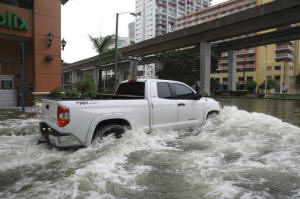|
Hurricane Irma pounds Florida; extent of
damage not yet clear
 Send a link to a friend
Send a link to a friend
 [September 11, 2017]
By Adrees Latif and Zachary Fagenson [September 11, 2017]
By Adrees Latif and Zachary Fagenson
TAMPA, Fla.,/MIAMI (Reuters) - Hurricane
Irma pounded heavily populated areas of central Florida on Monday as it
carved through the state with high winds, storm surges and torrential
rains that left millions without power, ripped roofs off homes and
flooded city streets.
Irma, once ranked as one of the most powerful hurricanes recorded in the
Atlantic, came ashore in Florida on Sunday and battered towns as it
worked its way up the state.
The storm gradually lost strength, weakening to a Category 1 hurricane
overnight, the National Hurricane Center said. By 5 a.m. ET (0900 GMT),
Irma was churning northwest in the center of the state and was about 60
miles (100 km) north of Tampa, with maximum sustained winds of 75 miles
per hour (120 km per hour.)
Much of the state's east and west coasts remained vulnerable to storm
surges, when hurricanes push ocean water dangerously over normal levels.
That risk extended to the coast of Georgia and parts of South Carolina,
the hurricane center said.

Officials planned to wait until first light on Monday to begin rescue
efforts and assess damage, the Miami Herald cited Florida Director of
Emergency Management Bryan Koon as saying. He did not give any numbers
on possible fatalities.
Damage appeared to be severe in the Florida Keys, where Irma first came
ashore as a Category 4 hurricane with sustained winds of up to 130 mph
(215 kph) in the early hours of Sunday, the paper quoted Monroe County
Emergency Director Martin Senterfitt as saying.
A large military airborne relief operation was being prepared to take
help to the chain of islands, which are linked by a dramatic series of
bridges and causeways from Key Largo almost 100 miles (160 km) southwest
to the city of Key West, Senterfitt told a teleconference.
Early on Monday, Irma brought gusts of up to 100 mph (160 kph) and
torrential rain to areas around Orlando, one of the most popular areas
for tourism in Florida because of its cluster of theme parks, the
National Weather Service said.
In Daytona Beach, a city on the east coast about 55 miles (90 km)
northeast of Orlando, city streets were flooded and emergency
authorities carried out several water rescues, the Daytona Beach Police
Department said on Twitter.
Over the weekend, Irma claimed its first U.S. fatality - a man found
dead in a pickup truck that had crashed into a tree in high winds in the
town of Marathon, in the Florida Keys, local officials said.

The storm killed at least 28 people as it raged westward through the
Caribbean en route to Florida. Irma was ranked a Category 5, the rare
top end of the scale of hurricane intensity, for days, and carried
maximum sustained winds of up to 185 mph (295 kph) when it crashed into
the island of Barbuda on Wednesday.
Ahead of Irma's arrival, some 6.5 million people in southern Florida,
about a third of the state's population, were ordered to evacuate their
homes.
Jonathan Brubaker, 51, waited out the storm bunkered in a recently
constructed house in Bradenton, on the state's west coast, with
hurricane shutters drawn, flashlights and candles ready. As a radar app
on his phone showed Irma passing by, he had seen little more than gusty
winds. He still had power.
"I feel like we kind of dodged bullet on this one," he said, adding that
he would wait until Monday morning before trying to sleep. "And then, I
think we’re OK, knock on wood."
[to top of second column] |

Flooding in the Brickell neighborhood as Hurricane Irma passes
Miami, Florida, U.S. September 10, 2017. REUTERS/Stephen Yang

MILLIONS WITHOUT POWER
High winds snapped power lines and left about 5.8 million Florida
homes and businesses without power, state data showed.
Many of the evacuation orders extended until at least Monday due in
part to flooding, massive power outages and downed electric lines,
leaving residents unable to return to their homes to survey any
damage.
TV news video of damage in Naples, a city on the Gulf coast about
125 miles (200 km) northwest of Miami, showed buildings ripped apart
by winds and streets flooded by rain and storm surges.
Miami International Airport, one of the busiest in the country,
halted passenger flights through at least Monday.
Irma was forecast to weaken to a tropical storm as it moved near
Florida's northwestern coast on Monday morning, the National
Hurricane Center said. It would cross the eastern Florida Panhandle
and move into southern Georgia later in the day, dumping as much as
16 inches (41 cm) of rain, it said.
SKYSCRAPERS SWAY IN LASHING WINDS
Five tornados were reported in Florida on Sunday, causing damage to
several structures but there were no indications of anyone being
seriously injured, the National Weather Service said.

Along with hurricane warnings and watches in Florida, the weather
service placed tropical storm warnings for large parts of Alabama,
Georgia and South Carolina.
The densely populated Miami area was spared the brunt of Irma,
although the hurricane's wide reach meant the state's biggest city
was still battered.
Miami apartment towers swayed in the high winds on Sunday, three
construction cranes were toppled, and streets flooded between office
towers.
Police in Miami-Dade County said they had made 29 arrests for
looting and burglary.
The storm and evacuation orders caused major disruption to
transportation in the state, which is a major tourist destination
and which accounts for about 5 percent of U.S. gross domestic
product.
Irma, which hit just days after the Houston area was deluged by
unprecedented flooding in Texas from Hurricane Harvey, was expected
to cause billions of dollars in damage to the third-most-populous
U.S. state.
However, European shares rose on Monday in early deals, led higher
by insurers as the weakening of Irma raised expectations that costs
for the industry might be lower than initially feared.
(Additional reporting by Bernie Woodall, Ben Gruber and Andy
Sullivan in Miami, Letitia Stein in Detroit, Colleen Jenkins in
Winston-Salem, N.C., David Shepardson, Doina Chiacu and Roberta
Rampton in Washington and Scott DiSavino in New York; Writing by
Scott Malone and Jon Herskovitz; Editing by Frances Kerry)
[© 2017 Thomson Reuters. All rights
reserved.]
Copyright 2017 Reuters. All rights reserved. This material may not be published,
broadcast, rewritten or redistributed.
 |